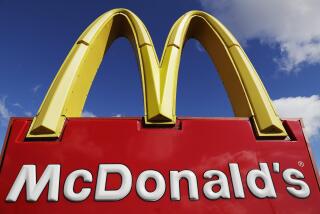Kellogg Cuts Prices in Cereal Food Fight
- Share via
The breakfast cereal price war heated up Monday as market leader Kellogg Co. slashed prices on some of its most popular brands an average of 19%.
Kellogg said the move, affecting such leading brands as Frosted Flakes and Froot Loops, will reduce retail costs on about two-thirds of Kellogg’s cereal volume in the United States.
Analysts expected other cereal makers to follow with price reductions on brands that compete with Kellogg cereals. They said General Mills, the second-largest cereal maker, may be forced to reduce prices on children’s cereals.
Kellogg has been losing sales to Post, which in April shook up the industry by cutting its prices an average of 20%. Post’s share of the market has grown by about 4 percentage points, mostly at the expense of Kellogg and store brands, industry analysts said.
Kellogg acknowledged that Post’s reductions spurred it to act. Thomas A. Knowlton, president of Kellogg-North America, said the company had planned to pass along savings when it completed a $90-million cost-reduction program begun last year.
“We’re accelerating the execution of the price reductions,” Knowlton said. “It was always in our plan to take prices down.”
Reductions range from 28% on Smacks to 4% on the Kellogg assortment pack. The company said that as a result of the price cuts, it will rely less on cents-off coupons. Post, the No. 3 cereal company, announced a similar strategy in April.
Analysts said price reductions should go a long way toward helping Kellogg recapture sales lost to Post over the last several weeks. Kellogg’s share of the $8.9-billion cereal industry fell by 3 percentage points to about 32%, while Post’s grew to about 20%. Each percentage point represents about $90 million in sales.
Mark Leckie, general manager of Post, a unit of Philip Morris Cos., said he expects that Post will continue to gain market share, despite Kellogg’s move. He downplayed his rival’s move, calling it “a limited pricing action.”
“If you are a Rice Krispie user or a Corn Flake user, you are not going to see lower prices,” Leckie said.
Kellogg said it made the cuts on a case-by-case basis.
The cereal companies are using the price cuts to reinvigorate the stagnant branded cereal business, which has been under pressure from inexpensive store brands and popular alternatives to cereal, such as doughnuts or bagels. In 1995, sales of store-brand cereals grew 10.8%, while total cereal sales fell 3.3%, according to Information Resources, a market-share tracking firm.
PaineWebber analyst George L. Staphos said cereal makers have been hurt by a lack of product innovation. He said new products will help convince consumers to eat cereal rather than grab a bagel on the way to work. Most new cereals have fallen flat; among the exceptions are General Mills’ sweetened Cheerios and Post’s Waffle Crisp.
Price cuts “will help restore growth, but it is still too early to determine if it is the sole factor,” Staphos said.
“The competition has been built on who can produce the biggest incentive to consumers, whether it is a coupon or buy-one, get-one-free,” Kellogg’s Knowlton said. “We want to be more innovative in the future.” He said the company is completing a $65-million research center in Michigan to focus on product innovation.
Industry analysts said other cereal makers are likely to follow Kellogg’s move with selective price cuts. General Mills and Quaker Oats have brands that are distinctive and don’t compete directly with cereals from Kellogg or Post. Even so, General Mills might feel pressure to lower the price of Trix, a children’s cereal that competes with Kellogg’s Froot Loops, said Steven M. Galbraith, an analyst with Sanford C. Bernstein & Co. in New York.
General Mills and Quaker didn’t indicate whether they would respond to Kellogg’s action. Quaker pointed out that it has a line of bargain-priced cereals that are sold in bags.
Ralcorp Holdings, the biggest manufacturer of private-label cereal, Monday announced a round of cost cutting that would give the company the flexibility to lower its prices.
“In order to remain competitive, we felt it was imperative that we remove costs from our system,” said Ralcorp Chief Executive Richard A. Pearce. “If the category is going to be driven by price, then we will make the modifications needed to succeed in that environment.”
He said sales cuts announced by Kellogg and Post could strip $1 billion in sales from the cereal industry. Kellogg said it expects to fund the price reduction from savings generated from its cost-cutting program. The company said its margins will be affected because it has agreed to “protect” retailers from losses on cereal stock purchased at higher prices.
Kellogg said earnings in the second quarter ending June 30 should decline to 45 cents a share from 77 cents a year ago. Earnings for the year are expected to be the same as a year ago.
Kellogg’s shares closed at $72 on Monday, down $2.875 in trading on the New York Stock Exchange.
(BEGIN TEXT OF INFOBOX / INFOGRAPHIC)
Snap, Crackle, Profit
Cereal has the highest profit margin of any food according to a report by Rep. Charles Schumer (D-N.Y.) and Rep. Sam Gejdenson (D-Conn.) that calls on the Justice Department to investigate possible antitrust violations by cereal makers. A look at where money spent on a box of cereal goes:
Advertising: 37.5%
Profit: 17.0%
Capital costs: 12.5%
Packaging: 11.5%
Other Ingredients: 8.5%
Labor: 6.5%
Grain: 6.5%
Source: Wire reports
Researched by JENNIFER OLDHAM / Los Angeles Times
More to Read
Inside the business of entertainment
The Wide Shot brings you news, analysis and insights on everything from streaming wars to production — and what it all means for the future.
You may occasionally receive promotional content from the Los Angeles Times.










